Quiz Review
1/29
There's no tags or description
Looks like no tags are added yet.
Name | Mastery | Learn | Test | Matching | Spaced |
|---|
No study sessions yet.
30 Terms
b
what is the first thing you should consider doing if someone in the lab catches on fire?
a. nothing; watch them burn
b. pat them out as fast as you can
c. grab a fire extinguisher and put them out
d. drag them to the emergency shower and put them out
d
No open toe or open heel shoes are worn in the lab because:
a. its too cold in the lab
b. you might trip or fall down
c. who wants to look at feet?
d. broken glass or chemical spills may get into this kind of shoe
b
what may you pour down the sink?
a. anything water based
b. only those things the instructor says you can
c. nothing at all
d. bottled water
d
what should you do if you are not sitting in your lab chair?
a. dance
b. sing
c. sing and dance
d. push the darned thing in so no one stumbles over it!
a
what is the first thing you do should someone at your bench spills or breaks something?
a. stop moving until the instructor makes sure there is no glass that will cut you
b. clean up the spill yourself
c. tell the instructor or a TA so they can decontaminate the area
d. nothing if you think it doesn’t matter
a
true or false: in this lab you must carry test tubes in a test tube rack, not in your hands.
a. true
b. false
c. depends on what is in the test tube
d. eat it
d
the biggest risk of injury in this lab is:
a. face eating bacteria
b. an angry pack of chihuahuas
c. boredom
d. FIRE!
e. your mom
a
what must you do when entering and leaving the lab?
a. wash your hands
b. say hello and/or goodbye
c. remind yourself, you could have signed up for tennis
d. wear a mask
d
in order to properly dispose of a contaminated substance in the lab you must:
a. if you think that it is safe, you must throw it away
b. hide it in you bench drawer
c. ask one of your bench partners.
d. place it in biohazard container
b
what should you do with long hair and/or head scarves when working in the lab?
a. cut the hair, toss the scarf
b. tie the hair and/or scarf behind you
c. set em on fire and get it over with
d. nothing
d
to prepare and maintain a relative sterile work area, you use:
a. 70% alcohol sprayed on the bench
b. a lighted bunsen burner
c. aseptic technique
d. all the above
b
the term sepsis refers to:
a. the presence of microorganisms
b. the presence of growing microorganisms
c. infection
d. the absence of any living microorganism
d
to sterilize living tissue, you must use a:
a. Cidal
b. static
c. hot water and soap
d. trick question; you cant sterilize living tissue
d
non-living surfaces are called:
a. sterile
b. septic
c. aseptic
d. fomites
a
microbiocides are used on ___________ while microbistatics are used on ____________.
a. fomites, living tissue
b. living tissue, fomites
c. bacilli and cocci, irregular bacteria
d. floors, ceilings
c
an infection by a microbe while a person is in the hospital is classified as:
a. just one of those things
b. an engineered infection
c. a nosocomial or clinically acquired infection
d. unpreventable
d
why must you wait for your inoculating loop to cool before using it?
a. a hot loop will kill a few millions of the specimen cells leaving only hundreds of millions left for you to use
b. it may smell bad
c. you may damage the loop
d. the specimen may aerosolize and be ejected into the air for you to breathe or absorb through your eyes
d
if streptococcus pyogenes is normal microbiota of the throat, why don’t you have strep-throat?
a. it is not normal microbiota of the throat
b. streptococcus pyogenes grows slower than your own cells
c. because it is a bacilli-form bacteria; harmless
d. microbial competition
c
what device do you use to move/transfer a sample of a microorganism from one chamber to another?
a. your finger
b. your co-worker’s finger
c. an inoculating loop
d. just pour it from one to the other
a
if you cannot sterilize your hands by washing them, why bother?
a. you will remove some organisms and inhibit the remainder, making your hands aseptic
b. you shouldn’t
c. you can sterilize your hands if you use hot enough water and soap
d. it’s a rule!
d
what is the colony elevation in the picture?
a. flat
b. raised
c. frosted
d. umbonate
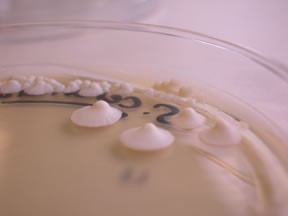
c
what is the texture of the colonies in this picture?
a. frosted
b. dry
c. shiny, mucoid
d. filamentous

a
what is the margin of the colonies in this picture?
a. entire
b. irregular
c. lobate
d. filamentous
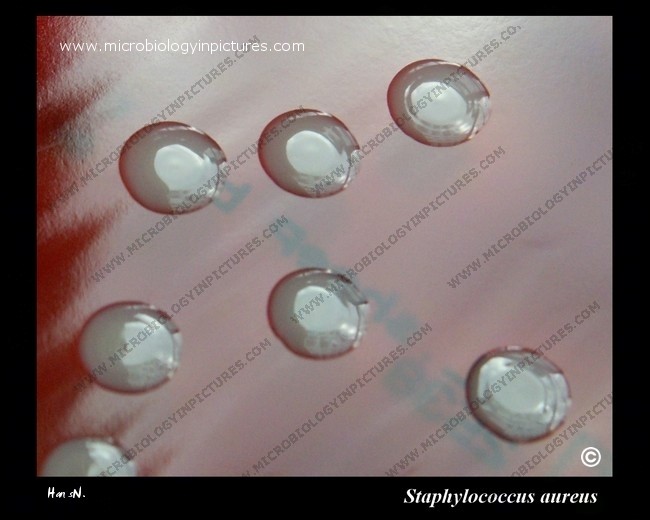
d
what is that “skin” that develops on the surface of a broth media and is evidence of growth called? see picture to the right
a. turbidity
b. flocculant growth
c. pigmentation
d. a pellicle
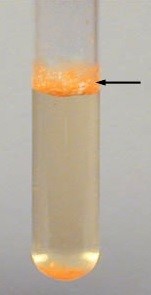
d
what is the margin for bacillus cereus in the picture?
a. entire
b. serrate
c. lobate
d. filamentous
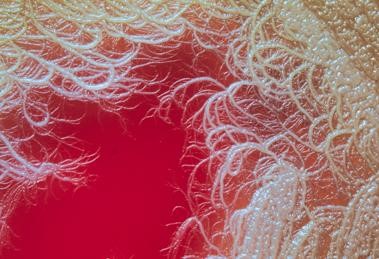
a
describe the broth culture in tube B in this picture:
a. turbid
b. sedimented
c. has a pellicle
d. pigmented

d
what are the signs of growth (of microorganisms) in a liquid medium?
a. the liquid may become cloudy
b. the liquid may change color
c. the liquid may acquire an odor
d. all the above
e. none of the above
c
describe the form of colony growth in this picture
a. irregular
b. slow
c. swarming
d. undulate
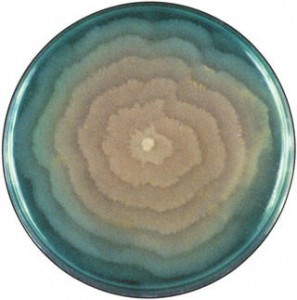
b
true or false. colony morphology is an indicator of virulence.
a. true
b. false
b
true or false. ALL bacteria produce pigmented colonies
a. true
b. false